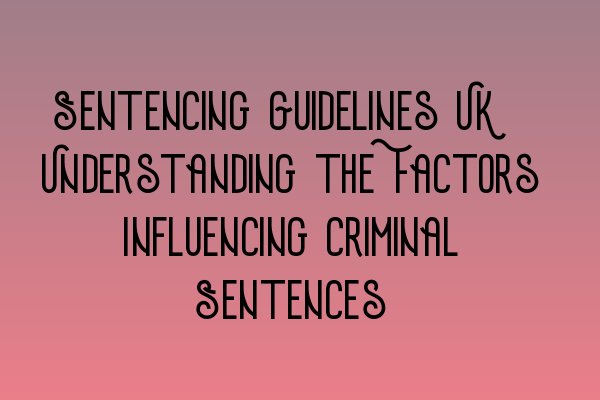Sentencing Guidelines UK: Understanding the Factors Influencing Criminal Sentences
When it comes to criminal law in the UK, understanding the factors that influence criminal sentences is crucial. Sentencing guidelines provide a framework for judges to determine the appropriate punishment for an individual convicted of a crime. These guidelines take into account a variety of factors, ranging from the severity of the offense to the offender’s personal circumstances. By examining these factors, we can gain a deeper understanding of how sentences are determined in the UK.
Severity of the Offense
One of the primary considerations in determining a criminal sentence is the severity of the offense committed. Different offenses carry different levels of seriousness, and the Sentencing Council provides guidelines outlining the appropriate punishments for each offense. For example, a minor theft may result in a fine or community service, while a violent assault could lead to a custodial sentence. These guidelines ensure consistency and fairness in the sentencing process.
Aggravating and Mitigating Factors
Alongside the severity of the offense, judges also weigh the presence of aggravating and mitigating factors. Aggravating factors are elements that make the offense more serious, such as premeditation or a history of similar offenses. Mitigating factors, on the other hand, are circumstances that may lead to a lesser sentence, such as genuine remorse or a lack of criminal history. These factors are carefully considered to determine the appropriate sentence within the sentencing range specified in the guidelines.
Victim Impact
The impact on the victim is another crucial factor in the sentencing process. Judges take into account the harm caused to the victim and the wider community when determining the punishment. This includes physical, emotional, and financial harm inflicted on the victim. The more severe the harm, the more likely it is that the offender will receive a more severe sentence.
Offender’s Personal Circumstances
Recognizing the individual differences of offenders, the sentencing guidelines also consider the personal circumstances and characteristics of the offender. This may include factors such as age, mental health issues, drug addiction, or socio-economic background. Judges aim to tailor the sentence in a way that reflects the unique circumstances of the offender, ensuring that both the punishment and rehabilitative measures are appropriate and effective.
Public Interest and Rehabilitation
In addition to the specific factors mentioned above, the sentencing process aims to balance the interests of the public, the victim, and the offender. The sentence should not only provide appropriate punishment but also strive for rehabilitation and the prevention of future criminal behavior. This may involve imposing community service, probation, or rehabilitation programs to address the underlying causes of the offense.
Understanding the factors influencing criminal sentences is crucial for anyone involved in the criminal justice system, including defendants, lawyers, and even the general public. By familiarizing ourselves with the sentencing guidelines, we can develop a clearer understanding of how sentences are determined and the considerations that judges take into account.
If you found this article informative, you might also be interested in the following related articles:
- LLC Formation Made Simple: Step-by-Step Guide for UK Entrepreneurs
- Business Regulations in the UK: A Comprehensive Overview
- Preparing for the SQE Exam: Strategies and Resources for Success
- SQE Workshops and Webinars: Accelerate Your Exam Preparation
- Delaware Corporate Law for UK Solicitors: Key Insights and Practices
